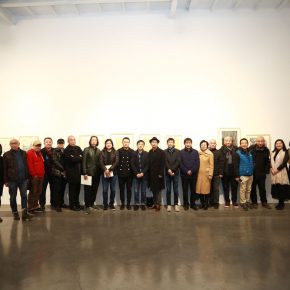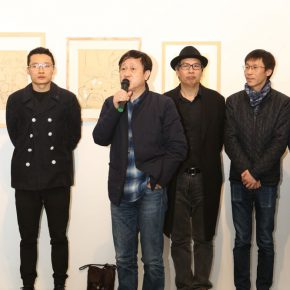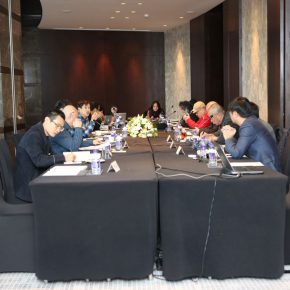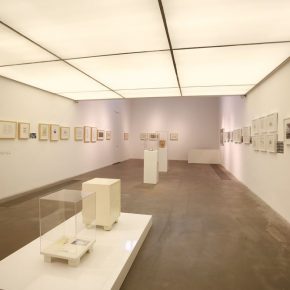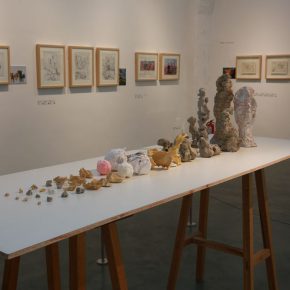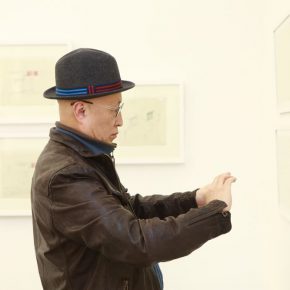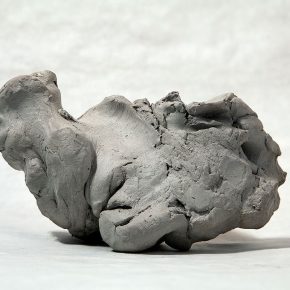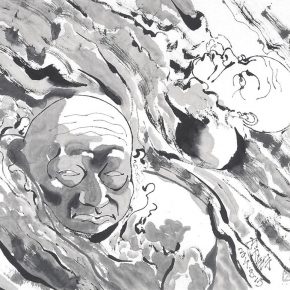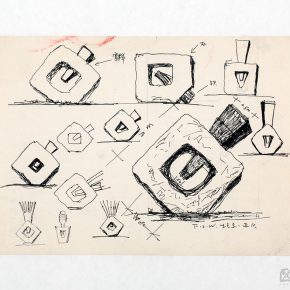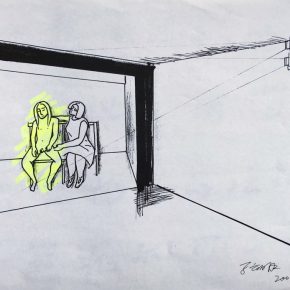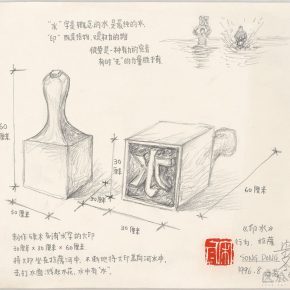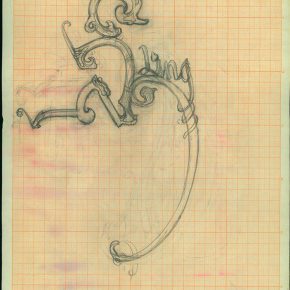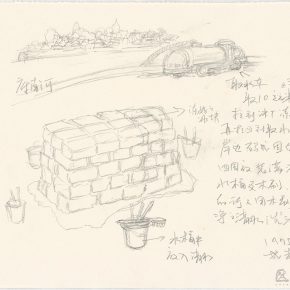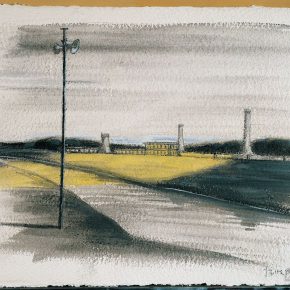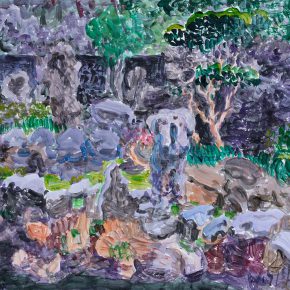
On the afternoon of November 25, 2017, “The Research Exhibition of Chinese Contemporary Art Masters' Manuscripts (First Chapter)” was held in the Triumph Gallery, Lu Hong was invited to serve as a curator, inviting ten artists including Fang Lijun, Fu Zhongwang, Ma Liuming, Song Dong, Sui Jianguo, Wang Guangyi, Xu Bing, Yin Xiuzhen, Zhou Chunya, Zhang Xiaogang to showcase their precious manuscript works. At the same time, a seminar related to the exhibition was held with honored guests including Lu Hong, Liu Chun, Sun Zhenhua, Wang Chunchen, Wang Duanting, Zhao Li, Duan Jun, Ji Shaofeng, Sheng Wei, Yang Xiaoyan, Yu Ke, Thomas Eller, Lin Yawei, Xie Mu, Zhang Yanzi, Zhu Li and so on.
The word “autograph” generally means the drawings, sketches, or relative writings that artists did under certain creative intentions before the final works are finished. Compared with normal art works, autographs have features of improvisation, randomness, subsize, fast-made, etc., but they are of the same value of appreciation, and regardless of what media and techniques are used by the artists.
“Western scholars have always paid great attention to the research of prominent artists’ autographs.” The curator Lu Hong quoted a statement from the British art historian Gombrich’s essay “Leonardo's Method for Working out Compositions”, to point out the value of manuscript research: “In order to catch the imaginative thoughts, Leonardo da Vinci on the one hand advocated to sketch the unusual but wonderful thoughts in mind as soon as possible without considering the accuracy of shape; on the other hand, for inspiring creativity, he also advised artists to arouse association of composition ideas by watching ruins, unextinguished ashes, mottled stones, drifting clouds in the sky and dumped sketches. In the Western artistic research, the research and display of autographs are very important, firstly autographs can better reveal the meanings and connotation of certain art works; secondly the way artists solve different problems and how they effectively inherit the tradition or conduct their creations can be seen through studies of their autograph; thirdly people can even find the sign of artistic conceptions or expressive techniques transform in different times by doing specific autograph research.
The seminar was held before the opening of “The Research Exhibition of Chinese Contemporary Art Masters’ Manuscripts (First Chapter)”, and the honored guests had a discussion on the value orientation, research significance and category definition of the manuscript. Curator Lu Hong elaborated it with the focus on the manuscript’s “Privacy, Authenticity, Procedure”. He compared the intimacy of the manuscript with the fashion of “wearing underwear as outerwear”, namely the manuscript is regarded as the “underwear” of the work, while the majority of which is the process of artists’ self-dialogues. Secondly, the manuscript covers “authenticity”, through the manuscript one can understand the original psychology of the artist when he was working, and exposing the original motivation of the creator. Finally, the real “manuscript” is originally the record of the artist’s thinking instead of presenting the show, and the process can present the creative context. Prof. Zhao Li from the Central Academy of Fine Arts agreed that “manuscripts are records of artists’ creative thinking”, and he “revealed a hidden art history” through Leonardo's manuscript and Raphael’s sketch of “Madonna and Child”.
Prof. Wang Chunchen from the Central Academy of Fine Arts focused on the multi-extension of the boundaries of contemporary art, and the scope and connotation of manuscripts are worth discussing more widely – whether digital art or multimedia-based creative process recording can be considered as a draft? How can this definition be completely interpreted from material manuscripts to virtual manuscripts? How to define and sort drafts of such timely works as performance? As a result, the study on manuscripts can be continuously updated and interpreted with the enrichment of art categories. Scholar Liu Chun explored the “Significance of Manuscripts in the Study of Art History”. He said that the manuscript was the process of practice, seen from the inside of art history, while it was a collection of information, seen from the outside. He used a large number of cases from art history, such as Miller’s “the Gleaners” and the Impressionist creations to prove the view, there was a relationship between the manuscripts and the final works, which was the basis of the study of the manuscripts, while it also offered a different perspective on our social history, political history, and economic history.
The German scholar Thomas Eller expressed his opinion on manuscripts based on the aesthetic angle of Western culture, and first pointed out the difference between the semantics of manuscripts in the Chinese & Western contexts. In the West, manuscripts referred to “the handwritten expression”, while it included sketches & drawings in addition to handwritten texts in China and he affirmed the academic value of the study of manuscripts, based on the understanding of Chinese contemporary art. Thomas then took the topics of “Diary”, “Manuscripts” and “Manifesto” to lead a progressive discussion.
At last, Zhu Li, Editor-in-Chief of the CAFA ART INFO in Chinese, delivered a speech. From her personal experience, she started to think of “the value and significance of manuscripts” – can it be discussed as a form of work with an independent value of appreciation? She believed that the vivid, authentic and appealing manuscripts had a part which couldn’t be replaced by the formal works. In addition to the visual form and the value of the technical medium, the transmission of ideas & emotions is in the first place of artistic creation, while the manuscript was able to finish it, and was even more thought-provoking than the formal work. In addition, under the context of contemporary art, the connotation and boundaries of manuscripts were gradually blurred. What was the criterion of manuscripts? What were the relationships and differences between the manuscripts and formal works? These issues could be further discussed.
The exhibition opened at 4:00 pm and many important critics & artists attended the ceremony. Li Lanfang expressed her gratitude to the honored guests. The exhibition, which coincided with the tenth anniversary of the Triumph Gallery and can be regarded as both a summary for the gallery in the past decade, and a new starting point of the gallery. Curator Lu Hong guided the audiences to visit the show and expressed the hope of presenting another aspect of the artists through the manuscripts, so that people paid more attention to artists’ manuscripts in China and found a different way to study Chinese art. Artists Wang Guangyi, Fang Lijun and Ma Liuming delivered respectively a speech on behalf of the artists. It is the first chapter of “The Research Exhibition of Chinese Contemporary Art Masters' Manuscripts”, and Triumph Gallery is about to look for more artists to co-organize and hold a series of manuscripts in the future.
CAFA ART INFO will serialize precious manuscripts and related texts of “The Research Exhibition of Chinese Contemporary Art Masters' Manuscripts (First Chapter)”, please stay tuned.
Text by Zhang Yizhi, translated by Chen Peihua and edited by Sue/CAFA ART INFO
Photo by the organizer??
About the Exhibition??
Title: The Research Exhibition of Chinese Contemporary Art Masters' Manuscripts. (First Chapter) – The 10th Anniversary of Triumph Gallery
Curator: Lu Hong
Artists(Arranged in alphabetical order): Fang Lijun, Fu Zhongwang, Ma Liuming, Song Dong, Sui Jianguo, Wang Guangyi, Xu Bing, Yin Xiuzhen, Zhou Chunya, Zhang Xiaogang
Duration: November 25, 2017 – February 10, 2018
Venue: Triumph Gallery


